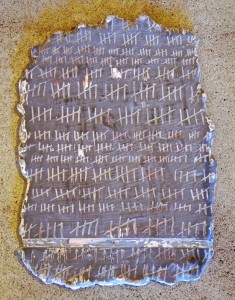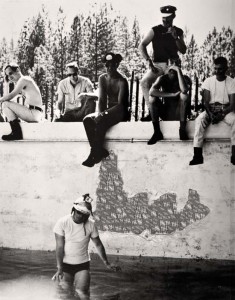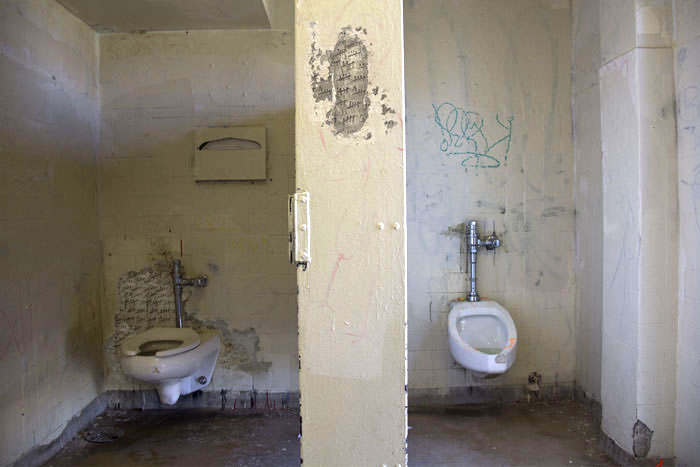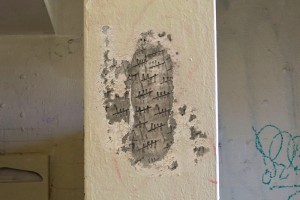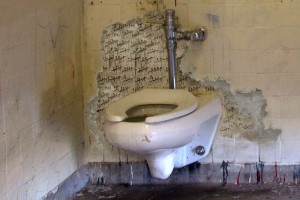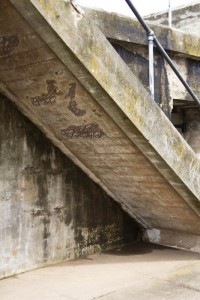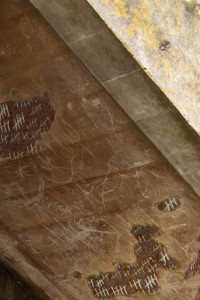Excavation of Contemporary Ruins (working title), developed by artists Daniel Dallabrida and Ida Rödén, involves the presentation of an archeological investigation. In this exhibition, the viewer is lead via audio guide through the artists’ exploration of these archeological finds—ceramic ruins and documentation in large-scale archival and excavation photographs. These ruins are set as background to San Francisco’s gay community prior to the Crisis Years of the HIV/AIDS epidemic. The focus of the project, however, is on eliciting the interpretation of these findings through contemporary eyes. The artists will present their constructions as their “discoveries.” It will be left to the viewer to provide the analysis.
All images should be seen as sketches for photographs to be.
The initial finding consists of a series of ceramic tablets discovered as Uncatalogued Objects in the archival collection of the GLBT Historical Society in San Francisco.[1] The two artists decide to investigate further. Their search through archived photographs (circa 1940-1990) leads to the discovery of these markings in the background of a variety of settings—the bars, bathhouses, beaches and other “cruising” sites that served as meeting places and community-building locales for gay men of this era.
The audio component offers the perspective of the two artists as they pursue their investigation in the GLBT archives. It follows them as they search San Francisco for the sites presented in the old photographs. As part of their effort to understand and interpret their findings the artists interview contemporary queer historians, theorists, curators, and artists from both sides of the HIV/AIDS generational chasm (e.g. Jonathan Katz, Mark I. Chester, Richard Bolingbroke, Tina Takemoto, Glen Helfend, Eric Scollan, Adrienne Skye Roberts, Race Bannon, Jack Fritscher). Portions of these interviews are found within the audio guide.
[1] The GLBT Historical Society houses one of the world’s largest collections of lesbian, gay, bisexual and transgender historical materials. http://www.glbthistory.org/research/index.html
The installation created will be minimal in its visual presentation in that it only consists of large-scale photographs, the ceramic tablets, and the guide. The photographs will include images from the archival collections as well as the artists’ discoveries of contemporary sites where traces of these ruins can still be found. It is through the narration of the audio that layers of meaning will be revealed. The viewer is guided through a story oscillating between being factual and mythical. The interviewees offer conflicting interpretations and analysis. The resulting installation asks fundamental questions regarding authorship and traditional history writing. Documenting a history that will not stay buried—that of a gay community before the era of HIV/AIDS—the project offers ways of talking about the Epidemic by suggesting it as an event yet to happen. A story is told. The degree of fiction becomes irrelevant.
THE COMPONENTS OF EXCAVATIONS OF CONTEMPORARY RUINS INCLUDE:
- Large-scale “excavation” photographs: These photographs depict different excavation sites where fragments of ceramic pieces containing inscriptions have been found. These sites are places of historical significant for the San Francisco gay community – they include Bad Boy Beach, Ft. Funston, the public restroom in Dolores Park, the outdoor deck of The Eagle. Each photograph will be manipulated in postproduction so that the inscription appears as an actual part of the environment. For example, the ceramic tablets will appear on cliffs at the beach, within old concrete military installations, or in a dark corner of a bar. Some photographs will have “archival” photographs sunk into them. These are historical photographs found in the GLBT Historical Society. These may show the inscriptions as a whole work or in part. In these images, taken the decades preceding the Epidemic, these markings are background to the action, accidentally caught by the photographer.
- Audio guide: The narration accompanying the photographs will be from an investigative viewpoint. Even though it will follow the investigation conducted by the two artists, it will be told from the voice of one single narrator. He will travel between different sites, visiting places seen in old photographs. He will visit and interview historians, art experts, and activists who will help shape a theory concerning these findings. In addition, newspaper articles are referenced, and personal histories are reflected upon. Some theories are farfetched and quite unlikely while others seem accurate since proofs have been provided.
- Shards of ceramic: These are the ceramic tablets found in the GLBT Historical Society archive. They will be presented in a vitrine in accordance with traditional museum displays.
WHY CONTEMPORARY RUINS?
“We live now, though we might say that we have always lived, in a time of ruination.” Brian Dillion
It was built for a ruin. The contemporary ruin has no history but is referencing history. It is not what it represents. There are no accuracies; only different versions based on fleeting memories. Here is the evidence not only of the fact that things can be destroyed but that they survive their own destruction. The contemporary ruin is built at one end while simultaneously falling apart and dissolving into nature at another. It is meant to disintegrate. It symbolizes the process of destruction, as well as creation. The contemporary ruin is a fragment with a future that is present only as absence. In Excavations of Contemporary Ruins, ruin-making has justified itself. The ruin has been made specifically as fragmentary object in the temporality of today. In these ruins, truths and histories are constantly recreated and actualities are lost.
_______________________________________________________________________________________________________________
ARTIST STATEMENT
Daniel Dallabrida is a story-teller, una racconta favole. He moves freely between the realms of process, ritual, installation, and artifact. Using sculpture, photography, words, sound, and social gatherings, he encourages people to experience the dimensional, winding current of the tales he tells.
Dallabrida’s primary purpose in making art and telling stories is to create a new means for identifying and building community. For him, artists possess the skill and bear the responsibility to round out each moment of life: uncovering subtlety in the face of awe, permanence in the face of erasure, ambiguity in the face of clarity, wonder in the face of horror. Art identifies the cracks in the foundations, he says. It illuminates the scaffolding of possibility.
In 2003, Dallabrida closed the door on a professional career and moved to Italy in pursuit of the art, culture, and language of his heritage. There he apprenticed at a family foundry near Venice. Then, attracted by the Tuscan tradition of anti-Fascist ceramic sculpture, he studied at Studio Arts Centers International in Florence, before completing an MFA at California College of the Arts in 2011.
While Dallabrida favors the materials of the earth and the phenomena of physics, neither wild nor urban land is his subject. Found or manipulated sites, clay, water, iron, and wood, and the body are co-conspirators, fusing to build the backgrounds and characters for the stories he tells. By combining material and story, Daniel Dallabrida creates new means to see the old, and uses old means to discover the new.
Ida Rödén is an interdisciplinary artist who works at the intersection of conceptual photography, creative writing, sculpture, and installation. In her art practice she shapes and blurs the boundaries between fact and fiction, reality and imagination. Her work paints an ambiguous yet accurate image of our own time and place and implies how we are all a literal part of every story. With lightness and a sense of humor she creates situations where the idea of authorship and history will be repeatedly questioned and reinvented. Associations and misunderstandings becomes one of her main ingredients.
In a nonexistent article, the fictional Mara Thompson claims “Ida Roden, strictly speaking, does not exist. She is several, is many, she is a profusion of selves. She splits herself into dozens of characters who recurrently contradict each other and even themselves. In doing so, she removes herself from her own persona. In the process she may lose herself, but what she really gains is the possibility of becoming anyone.”
Ida Rödén received her MFA at the California College of the Arts/San Francisco in 2011, and her MA in the History of Arts from the University of Stockholm in 2008. Her work has been shown at the MADE Festival in Sweden, Bildmuseet in Umeå/Sweden, Kunsthal Charlottenborg in Copenhagen/Denmark, the Künstlerhaus Bethanien in Berlin/Germany, The FILE Electronic Language International Festival in Sao Paolo/Brazil, Viridian Artists, New York City/New York, Center on Contemporary Art (CoCA) in Seattle/Washington, as well as Southern Exposure and the Wattis Institute in San Francisco/California. She is currently working toward her first museum solo show at the Art Museum of Sundsvall, Sweden. The show, taking the collection of the museum as its main working material, will open spring of 2014.
_______________________________________________________________________________________________________________
CV
Daniel Dallabrida
Education
2011, California College of the Arts, MFA, San Francisco, CA
2008, Studio Art Centers International, Post-Bacc, Florence, IT
2007, International Centre of Ceramic Art, Certaldo, IT
2006, Artistica Ferro Foundry, Apprenticeship, Preganziol, Veneto, IT
2005, Universitá per Stranieri, Italian 2nd Level, Perugia. IT
1982, Portland State University, BS Intercultural Communications, Portland, OR
Selected Exhibitions and Installations
2012, 6th Tropical Lab Exhibition, Land, Institute of Contemporary Art, Singapore
2012, Magnet, In Now’s black waters burn the stars of Then (Momento Mori), San Francisco, CA
2012, Magnet, Younger Than Jesus / Older Than AIDS (Performance), San Francisco, CA
2012, Pangaea Global AIDS Foundation, Traversata, Oakland, CA
2012, Anderson Ranch Art Center, Resident Open Studio, Snowmass Village, CO
2011, Magnet, Traversata /Crossing, San Francisco, CA
2011, Wattis Institute for Contemporary Arts, (Odds Are) 13-1, San Francisco, CA
2011, Wattis Institute for Contemporary Arts, Spheres w/ Kris Martin, San Francisco, CA
2011, Artists + Writers, Ουροβόρος/Ouroboros, San Francisco, CA
2010, Resnick Estate, Presence / Absence • Assenze /Presenza, Healdsburg, CA
2010, Wattis Institute for Contemporary Arts, Hammarby!, San Francisco, CA
2010, Silverman Gallery, Mirror Piece, San Francisco, CA
2010, PLAySPACE, -ennial, San Francisco, CA
2010, North South Gallery, 20 Jay Street, Oakland, CA
2009, Bell Guthrie Ranch, Crying Wolf / Grido al lupa, Mariposa, CA
2009, Concannon Greenberg, Every Place in the Heavens is Paradise / Ogni posto in cielo é paradiso, Lake Tahoe, CA
2009, Bell Guthrie Ranch, To be Traveler and Destination / Essere viaggiatore e destinazione, Mariposa, CA
2009, TeAmo, Tra le Mie Braccia Dormirai / In My Arms You Will Sleep, Venice, IT
2009, Wattis Institute for Contemporary Arts, CRV: Collaborative Re-Creational Vehicles w/ Abraham Cruzvillegas, San Francisco, CA
2009, City Art Gallery Group Show, San Francisco, CA
2009, San Francisco City College Gallery, San Francisco, CA
2008, Grand Canyon National Park, Odyssean Days, Obsidian Nights / Giorni di Odissea, Notti Ossidiane, Grand Canyon, AZ
2008, Festa Internaizonale della Ceramica, Vigilante / Guardian, Montelupo Fiorentino, IT
2008, La Corte Arte Contemporanea, Traversata Urbana: Una conversazione con il traffico fiorentino / City Crossing: A Conversation with Florentine Traffic, Florence, IT
2008, Palazzo delle Esposizioni and Museo San Giovanni de’ Fiorentini, L’Arte Dell’Uovo di Pasqua, Rome, IT
2008, Casellio Ovest di Porta Venezia, Mannucci International Competition of Sculpture, Special Edition / Premio Internazionale di Scultura Edgardo Mannucci, Milan, IT
2008, ArtSpan, Traversata: Le mie conversazioni con il Fiume Arno / Crossings: My Conversations with the River Arno, San Francisco, CA
2008, La Corte Arte Contemporanea, Buttarsi allo Sbaraglio / Jumping into the Deep End, Florence, IT
2008, Chiostro di San Francisco, Mannucci International Competition of Sculpture, 15th Edition / Premio Internazionale di Scultura Edgardo Mannucci, XV Edizione, Arcevia, IT
2007, SACI, Divintá del fiume Arno / Gods of the River Arno, Inchisa Valdarno, IT
2007, SACI, Traversata: Le mie conversazioni con il Fiume Arno / Crossings: My Conversations with the River Arno, River Arno, Incisa Valdarno, IT
2007, Galleria Palazzo dei Cartelloni, Studio Arts Center International, Florence, IT
2006, The Crucible, Oakland, CA
2006, ArtSpan, Trovarsi nel Mio Elemento /Found in My Element, San Francisco, CA
Residencies, Awards, Workshops
2012, Tropical Lab Residency and Exhibition, LaSalle University, Singapore, 2012
2012, Anderson Ranch Art Center, Artist in Residence, Ceramics, Snowmass, CO, 2012
2012, ARAC Board of Trustee Grant, Snowmass, CO, 2012
2012, California College of the Arts, Visiting Artist, Environmental Art, San Francisco, CA, 2012
2012, Anderson Ranch Art Center, January Studio Immersive, Snowmass, CO, 2012
2008-2013, Visual AID Grantee, San Francisco, CA, 2008-2013
2012, Dennis Leon/Christin Nelson Award, San Francisco, CA, 2012
2009, 2011, Brooks Fellowship Fund Grantee, Anderson Ranch Arts Center, Snowmass, CO, 2009, 2011
2010, New York Summer Residency Program, CCA, San Francisco, CA, 2010
Additional Experience
2001-03, Pangaea Global AIDS Foundation, establishing medical infrastructure for HIV care in Rwanda and South Africa.
1990-2003, Dallabrida & Associates, facilitating dialogue and collaboration between HIV/AIDS activists, non-profits, governmental organizations, patient communities and pharmaceutical companies.
Ida Rödén
Education
2009-2011, Master of Fine Arts, California College of Arts, San Francisco, CA
2006-2009, Bachelor of Fine Arts, Umeå Art Academy, Sweden
2000-2008, Degree of Masters of Arts with a major in the History of Art, Stockholm/Sweden
Solo Exhibitions
2014, (Upcoming, spring) “Handlaren Styfs Gård” (working title) The Art Museum of Sundsvall, Sundsvall/Sweden
2012, “Reported Missing” Unspeakable Projects, San Francisco, CA
2009, “Upgrade! Östersund” Östersund/Sweden
Selected Group Exhibitions
2013, (Upcoming, June 8 – October 6) “NordArt 2013″ Kunstwerk Carlshütte, Büdelsdorf, Germany
2013, “copy.right?” 33 Contemporary Gallery, Chicago, IL
2013, “The 3rd International and National Juried Photography Exhibition” Viridian Artists, NYC, NY
2012, “Electron Salon” Los Angeles Center for Digital Art (LACDA), Los Angeles, CA
2012, “Illusions” The Center for Fine Art Photography, Fort Collins, CO
2012, “Pop-Up Library: The Collectors” Monte Vista Projects, Los Angeles, CA
2012, “Ficciones” Krowswork gallery and project space, Oakland, CA
2012, “The Spring Exhibition 2012” Kunsthal Charlottenborg, Copenhagen, Denmark
2012, “Sphere of Influence” Worth Ryder Gallery, Berkeley, CA
2012, “2011 Annual Juried Show” Center on Contemporary Art (CoCA), Seattle, WA
2011, “Visions” Sacramento Fine Arts Center, Sacramento, CA
2011, “You First” UFORA, The Orange County Center For Contemporary Art, Santa Ana, CA
2011, “Proof” Southern Exposure, San Francisco, CA
2011, “MAGNITUDE 7.7″ Manifest Creative Research Gallery, Cincinnati, OH
2011, “MFA Thesis Exhibition” California College of the Arts, San Francisco, CA
2011, “Hammarby” CCA Wattis Institute for Contemporary Art, San Francisco, CA
2010, “Y-salongen” Länsmuseet Västernorrland (County museum of Northeastern Sweden) Härnösand/Sweden
2009, “Light Club” Gallery G60, Umeå/Sweden
2009, “Tourist Attraction” Projektraum, Künstlerhaus Bethanien, Berlin/Germany
2008, “FILE Electronic Language International Festival” Sao Paolo/Brazil
2008, “ARV” The Art Museum of Härnösand/Sweden
2008, “Game Art” Bildmuseet Umeå/Sweden
2007, “The MADE festival” Umeå/Sweden
Residencies, Awards, Workshops
2013, Stiftelsen Längmanska Kulturfonden
2013, Sparbanksstiftelsen Norrland, Ricklundstipendiet. Grant and residency in Saxnäs, Sweden
2012, Skowhegan Summer Residency
2012, Director’s Selection award for the exhibition “Illusions” in Fort Collins, CO
2011, The Wassaic Project Winter Residency
2010, Helge Ax:son Johnsons Stiftelse
2010, Fredrika-Bremer-Förbundets Stipendiestiftelse
2009, Västernorrlands läns kulturfond
2009, Anna Whitlocks Minnesfond
2009, Grafström och Sandquistska fonden
2008, Kjerséns minnesfond
2007, Kjerséns minnesfond
2007, Grafström och Sandquistska fonden
Additional Experience
2012 (spring), Artist Assistant for Bay Area artist Stephanie Syjuco, San Francisco, CA
2011-2012, Project Assistant for the estate of the figurative artist Joan Brown, San Francisco, CA
2011-2012 Photographer for ACES (Art Consultation + Estate Services), CA
2006-(ongoing), Freelance art critic for the online art Magazine volym.info
2010 (spring), Teaching Assistant for artist Maria Porges’s “Figure Sculpture” CCA, San Francisco
2010 (autumn), Teaching Assistant for artist Stephanie Syjuco’s “Sculpture 1″ CCA, San Francisco
___________________________________________________________________________________________________________________
Daniel Dallabrida and Ida Rödén were classmates at California College of the Arts, San Francisco. They graduated in May 2011. This is their first collaborative project.
